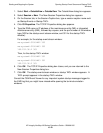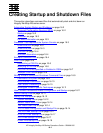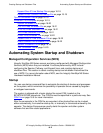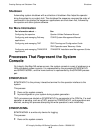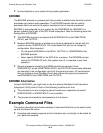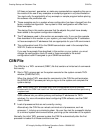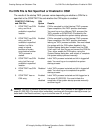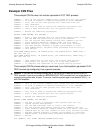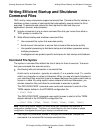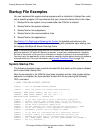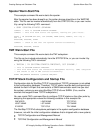
Creating Startup and Shutdown Files
HP Integrity NonStop NS-Series Operations Guide—529869-005
16-7
If a CIIN File Is Not Specified or Enabled in OSM
If a CIIN File Is Not Specified or Enabled in OSM
The results of the startup TACL process varies depending on whether a CIIN file is
specified in the CONFTEXT file and whether the CIIN option is enabled.
CONFTEXT CIIN Entry
and CIIN File
CIIN
Option Results
1. CONFTEXT has CIIN
entry, and file is
available in specified
location.
Enabled CIIN is executed by initial (startup) TACL process.
Upon completion, this TACL process terminates.
You must log on to a different TACL process (the
TACL process on $YMIOP.#CLCI started by the
CIIN file) to complete the system startup process.
2. CONFTEXT has CIIN
entry, and file is
available in specified
location, but file is
empty or aborts
because of syntax
errors before another
TACL process is
started.
Enabled CIIN is executed by initial (startup) TACL process.
Upon completion, this TACL process terminates,
leaving no TACL process available. You must reload
the system with the CIIN option disabled in the
System Startup dialog box invoked from the OSM
Low-Level Link; then log on and correct the CIIN file.
Then, either enable the CIIN option, using the
System Startup dialog box, and reload; or complete
the system startup process manually.
3. CONFTEXT has CIIN
entry, but file is not
available in specified
location.
Enabled Initial TACL process is started and left in logged-off
state. You must log on to complete the system
startup process.
4. CONFTEXT has CIIN
entry.
Disabled Initial TACL process is started and left in logged-off
state. You must log on to complete the system
startup process.
5. CONFTEXT has no
CIIN entry.
Enabled
or
disabled
Initial TACL process is started and left logged on to
the super ID (255,255). You must initiate the
remainder of the system startup process manually
and then log off.
Caution. Situation 5 presents a security issue: the initial TACL process is left logged on to the
super ID (255,255). You must either immediately continue with the system startup process (as
described in the Results column), log on to another user ID, or log off.



